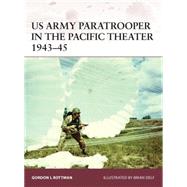US Army Paratrooper in the Pacific Theater 1943–45

US Army Paratrooper in the Pacific Theater 1943–45
- ISBN 13:
9781780961293
- ISBN 10:
1780961294
- Format: Paperback
- Copyright: 11/20/2012
- Publisher: Osprey Publishing
Rent
Sorry, this item is currently unavailable.
Note: Supplemental materials are not guaranteed with Rental or Used book purchases.
Extend or Purchase Your Rental at Any Time
Need to keep your rental past your due date? At any time before your due date you can extend or purchase your rental through your account.
Summary
Osprey's Warrior 26: US Army Paratrooper 1941-45 only covers one aspect of the US Army experience of World War I as it is only limited to the Euoprean and Mediterranean theatres of war. Airborne units also proved important in the Pacific Theatre, where they encountered a very different environment. The tow major Army units that operated in the Pacific - the 11th Airborne Division and the 503rd Parachute Regimental Combat Team (PRCT) launched small-scale operations on extremely difficult, if not, outright dangerous, terrain, while also conducting amphibious assaults, fighting on jungled hills, swamps and mud. The two units were very different, with the 503rd PRCT being reserved for special purpose missions and the 11th Airborne Division occupying a more traditional role. The 503rd launched the first successful US combat drop Nadzab on New Guinea in September 1943, and went on to conduct a number of other airborne operations on and around New Guinea, taking part in the amphibious assault on Mindoro in the Philippines, before capturing the island of Corregidor in February 1945. The 11th Airborne Division played a prominent role in the amphibious assault on Leyte in late 1944, and later the island of Luzon - which combined and airborne and amphibious assault. It also conducted the daring Los Banos raid to liberate civilian internees. This title will deal with the background to these two units, their training both stateside and in Australia, before detailing the specific equipment used in the theatre and, finally and most importantly, the combat experience at a personal level of the US Army Paratrooper in the Pacific.






